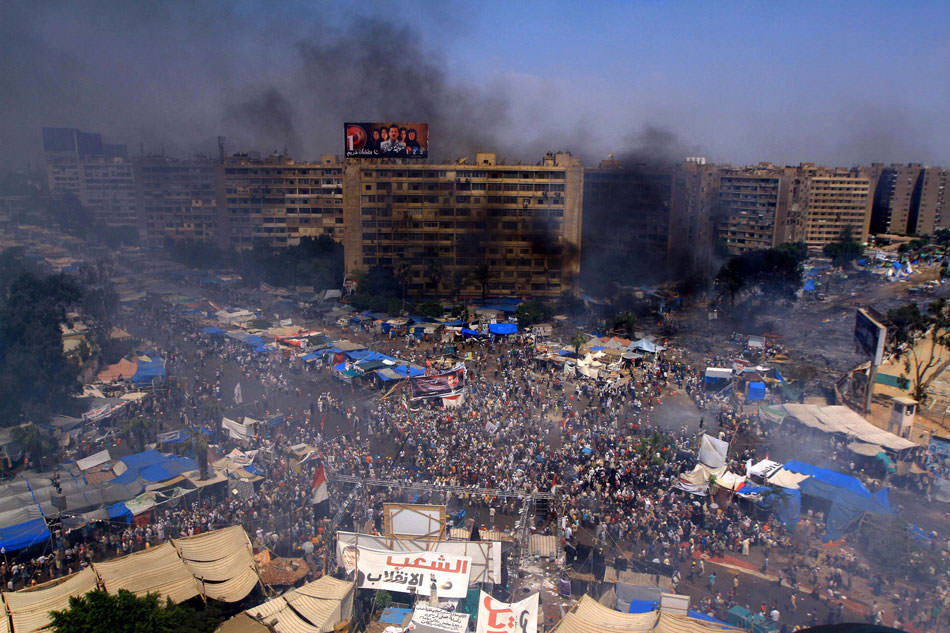The events in Cairo of August 14, in which Egyptian security forces confronted an estimated tens of thousands of supporters of ousted president Mohamed Morsi in al-Nahda Square and Rabaa Al-Adawiya Mosque, were widely covered around the world. According to the Egyptian Health Ministry, 638 people were killed that day. Of those, 595 were civilians, and 43 police officers.
Most reports in the international media described the protesters, who had been occupying two encampments since June 30, as unarmed and peaceful. As I write in the September 26 issue of The New York Review, however, it was clear, both from what I witnessed on the ground and from extensive footage recording the events that day, that a faction of the protesters were heavily armed, and that both Islamists and the police used live ammunition in the confrontation that followed.
According to both eye-witnesses and police involved in the operation, security forces first called for the protesters to leave peacefully via loudspeakers, then started to spray the camp with water cannons. By this point, some protesters had started to set civilian cars on the perimeter of the camp on fire. During the second round of calls for a “peaceful and safe exit,” as the police prepared to launch tear gas to push protesters out of the camp, they say that gunfire broke out from within the encampment and from a building filled with snipers believed to be allied with the pro-Morsi protesters. Islamists say it was the police who fired the first shots.
The videos below are a selection of the hundreds available showing some of what happened on August 14. They reveal a more complex reality of the events as they unfolded. The violence from both sides is evident.
On the morning of August 14, police call for a peaceful exit from the encampment at Rabaa through designated routes. They call on women and children to exit first, and warn of using violence or weapons against security forces, saying that the operation is being recorded.
Snipers believed to be allied with pro-Morsi protesters opened fire on police from an unfinished building overlooking the square, catching many unarmed demonstrators in the cross fire. Police said sixty snipers were arrested from that building alone. Throughout the video radio communication between police can be heard as they scan and climb the building, directing colleagues to the snipers on each floor. At the end two of the police force can be seen waving from the roof—signaling to the helicopter overhead that the operation was complete.
This video shows supporters of Morsi opening fire from within and around the camps. It also shows a coffin filled with ammunition discovered by police at one encampment.
As police forcefully moved in with armored personnel carriers to clear the sit-in at Rabaa, they exchanged gunfire with snipers in a building on the perimeter of the square. Here we see unarmed civilian protesters, who early in the video can be seen throwing rocks at the APCs, both caught in that cross-fire and taking fire directly from the police themselves. Most of those killed were unarmed, and caught in such exchanges.
This video, circulated by Muslim Brotherhood members, claims to show the moment that the daughter of Muslim Brotherhood leader Mohamed El Beltagy was shot. It is not clear that the figure shown in the video is Beltagy’s daughter, nor is it clear that the gunman is necessarily a police sniper, as the title of the video claims. It has been speculated that Islamist-allied agents might have been targeting their own people to stir chaos.
Following the dispersal at Al-Nahda, Morsi’s supporters moved to take over a nearby square in the residential district of Mohandiseen. Gunfire was exchanged between police forces and armed Islamists. The video shows police firing assault rifles at the Islamists.
This video compiles footage taken throughout the day of August 14. It begins in the morning with the police calling for protesters to leave peacefully. They announce that the dispersal is happening by a decree, and that it is happening in the full view of the media and civil society and rights organizations. The police ask people in surrounding buildings to close their windows and shutters for safety. As they are announcing this, at the 26 second mark, gunfire can be heard breaking out. Subsequent footage shows police firing tear gas guns, and later, scolding a father for having his young son present (“What would you do if he got hit by a bullet?”). We also see the police helping some of those frightened or affected by the teargas, and the safe exit that they had prepared for protesters. We then see the crates of Molotov cocktails the Muslim Brotherhood had made, and some residents cheering and ululating for the police.
Advertisement
Yasmine El Rashidi’s article “Egypt: The Misunderstood Agony” appears in the September 26 issue of The New York Review.


